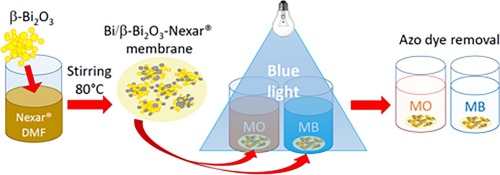Catalysis Today ( IF 5.2 ) Pub Date : 2017-12-15 , DOI: 10.1016/j.cattod.2017.12.013 D. D’Angelo , S. Filice , A. Scarangella , D. Iannazzo , G. Compagnini , S. Scalese

|
In this work Nexar®-based nanocomposite membranes, consisting of tert-butyl styrene end blocks, hydrogenated isoprene inner blocks and a middle block that is selectively and randomly sulfonated, were prepared by dispersing bismuth oxide (Bi2O3) nanoparticles inside. The aim was to evaluate their adsorption properties and photocatalytic activity. The chemical, structural and morphological properties of the produced materials were characterized by scanning electron microscopy (SEM), x-ray photoemission spectroscopy (XPS) and thermogravimetric analysis (TGA). We found that a partial reduction of Bi2O3 to metallic Bi takes place during the nanocomposite preparation. The presence of the bismuth-based nanomaterials changes the light absorbance of the polymer affecting positively the dye removal ablity of the polymeric nanocomposite. The removal/degradation properties of the membranes were investigated by measuring the degradation of two dyes, methylene blue (MB) and methyl orange (MO), under UV/visible or blue light illumination. The UV–vis light irradiation increases the MB removal for both the membranes, due to an enhanced adsorption effect, while blue light irradiation induces a similar enhancement only for the filler-free membrane. For the nanocomposite membrane containing Bi2O3 (s-PBC-BO) we observe the highest efficiency in the removal of MO under blue light irradiation due to a combined effect of light absorption by both the nanocomposite and the dye.
中文翻译:

的Bi 2 ö 3 / Nexar的®聚合物纳米复合膜为偶氮染料去除通过UV-vis或可见光照射
在这项工作中的Nexar ®系纳米复合材料薄膜,包括叔丁基苯乙烯末端嵌段,氢化异戊二烯内部块和中间块,其选择性和随机磺化,通过氧化铋(Bi分散制备2 ö 3)的纳米颗粒的内部。目的是评估它们的吸附性能和光催化活性。通过扫描电子显微镜(SEM),X射线光电子能谱(XPS)和热重分析(TGA)表征了所生产材料的化学,结构和形态特性。我们发现Bi 2 O 3的部分还原在纳米复合材料制备过程中,金属Bi的生成过程开始。铋基纳米材料的存在改变了聚合物的光吸收,从而积极地影响了聚合物纳米复合材料的染料去除能力。通过在紫外/可见光或蓝光照射下测量两种染料亚甲基蓝(MB)和甲基橙(MO)的降解,研究了膜的去除/降解特性。紫外线可见光照射增加了吸附效果,从而增加了两种膜的MB去除率,而蓝光照射仅对无填料的膜产生了类似的增强作用。对于含有Bi 2 O 3的纳米复合膜 (s-PBC-BO)我们观察到在蓝光照射下去除MO的效率最高,这是由于纳米复合材料和染料吸收光的综合作用。









































 京公网安备 11010802027423号
京公网安备 11010802027423号